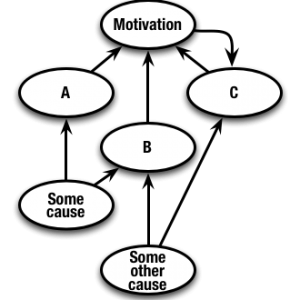In a conversation during the last agile coach camp Germany I was reminded of something I see often in agility: motivational interventions. Most, if not all, agile coaches use them in one form or another: a workshop moderated with a pot of energy on their side, a training where the reasons why agile is what it is are many times evangelistically explained with the goal of inspiring the participants, various games where motivation is either the goal itself or at least an important by-product.
Yet, when I make a systemic analysis of actual organisations, motivation would be more likely an effect of other aspects rather than a cause, i.e. there are many causes for motivation (or for the lack thereof, of course), but the circular causality around motivation impacts way less of these causes. In the diagram below, A, B and C influence motivation, while motivation influences only C.

Yet, many coaches do work with motivational coaching interventions and they do work… Hmmm… What’s going on here?
Let’s consider circularity: in a [complex] system cause and effect are blurred by what is called circularity. This means that some situation X, that seems to be an effect, is actually a cause of something that is the cause of X: a loop, usually self-reinforcing. This is why directly influencing motivation seems to work: you get to influence positively many other aspects of your team. BUT you are still not removing the other reasons for a lack of motivation. This means that, if you’re lucky, the positive spiralling upwards you create injecting motivation will overcome everything else and your team will effectively work in a new way. But more often than not, as soon as you stop injecting motivation the other causes of demotivation will keep working against you.
Ever heard that, as soon as the agile coach was gone, nothing worked anymore? That’s why!
On the top of that, when you are “motivating people” you are, in fact, extrinsically motivating, i.e. not exactly the motivation you want to promote in the team: try to get intrinsic motivation instead!
Other options?
- Look at the causes of demotivation and address them. As Herzberg would say, put hygiene in the workplace!
- Change the system constraints in order to favour intrinsic motivation and let the team grow
- Do a cause-effect analysis and understand how the various variables are related. Just be aware that what you found is an approximation of the real thing and that complex adaptive systems like teams are not predictable (as often a cause-effect analysis seems to suggest), so please remember to work with small probe-sense-respond safe-fail experiments
